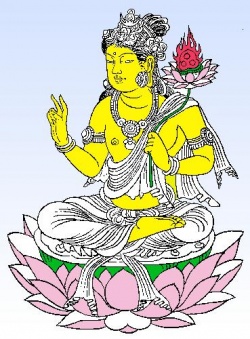Sarvanivaranavishkambhin
Sarvanivaranavishkambhin (Skt. Sarvanīvaraṇaviṣkambhin; Tib. སྒྲིབ་པ་རྣམ་སེལ་, Dripa Namsel; Wyl. sgrib pa rnam sel or sgrib pa thams cad rnam par sel ba) — one of the eight great bodhisattvas. He is often depicted as reddish-yellow in colour and holding a wheel of jewels.
Sarvanīvaraṇaviṣkambhin (सर्वनीवरणविष्कम्भिन्).—(once, Dharmasaṃgraha , Sarvani; in Kāraṇḍavvūha always falsely printed Sarvaṇī), name of a Bodhisattva: Mahāvyutpatti ; Dharmasaṃgraha 12 (compare above); (Ārya-) Mañjuśrīmūlakalpa ; n. sg. bhinaḥ (a-extension) (Ārya-) Mañjuśrīmūlakalpa ; abbreviated to Sarvanīvaraṇa (Ārya-) Mañjuśrīmūlakalpa (prose; but Tibetan renders Nīvaraṇaviṣkambhin, omitting sarva-, Lalou, Iconographie, ); Kāraṇḍavvūha
In Tantric Buddhism, he is usually placed in the lineage of Amoghasiddhi Buddha, one of the five Dhyani Buddhas, more rarely of Akshobhya Buddha. He is sometimes considered a form of Vajrapāṇi, though this is most likely a confusion with the mahāsattva Mahāsthāmāprāpta which Vajrapāṇi is one of its incarnations.
In iconography, he has often a flower in one hand, sometimes with a jewel (Cintamaṇi).
He is mentioned in the Lotus Sutra, in which he pays homage to Avalokiteśvara, and in the Mahavairocana Tantra.
The mantra of this great bodhisattva to remove all obstacles and disturbances mentioned in the Vairocana-sūtra, is as follows:
namaḥ samantabuddhānāṃ/ aḥ/ sattva hitābhyudgata/ traṃ/ traṃ/ raṃ/ raṃ/ svāhā
Nivāraṇa
Although the eight Mahāsattvas belong to the current Mahāyāna, the term nivāraṇa is most commonly used in the Theravada texts where it refers to the five mental obstacles:
distraction and worry (uddhachcha-kukuchcha),
doubts (vichikicha) towards the Three Jewels.
Sarvanivāraṇaviṣkambhi is best known to meditators and is not an important subject to individual worship like the other seven mahāsattvas.
Further Reading
- Jamgön Mipham, A Garland of Jewels, (trans. by Lama Yeshe Gyamtso), Woodstock: KTD Publications, 2008
See Also
Sarvanivaraṇaviṣkambhin (सर्वनिवरणविष्कम्भिन्) is one of the sixteen bodhisattvas appearing in the Vajradhātu-mahāmaṇḍala, according to the Nāmamantrārthāvalokinī v5.38-41. The Nāmamantrārthāvalokinī (literally, ‘an explanation of the nāma-mantras’) is a commentary (ṭīkā) on the 8th century Mañjuśrīnāmasaṃgīti.
Sarvanivaraṇaviṣkambhin is a name of Mañjuśrī (the embodiment of non-dual knowledge) and, together with other names, forms the core essence of the Mañjuśrīnāmasaṃgīti. The Nāmamantrārthāvalokinī provides the practitioner a sādhana (‘meditative practice’) to turn these names into mantras. These mantras are chanted for the benefit of all beings, and then placed and contemplated in the Vajradhātu-mahāmaṇḍala, which is an extended version of the Vajradhātu-maṇḍala.
Source: Wisdom Library: Tibetan Buddhism
Sarvanīvaraṇaviṣkambhin (सर्वनीवरणविष्कम्भिन्) is the name of a Bodhisattva mentioned as attending the teachings in the 6th century Mañjuśrīmūlakalpa: one of the largest Kriyā Tantras devoted to Mañjuśrī (the Bodhisattva of wisdom) representing an encyclopedia of knowledge primarily concerned with ritualistic elements in Buddhism. The teachings in this text originate from Mañjuśrī and were taught to and by Buddha Śākyamuni in the presence of a large audience (including Sarvanīvaraṇaviṣkambhin).
Source: archive.org: The Indian Buddhist Iconography
1) Sarvanivaraṇaviṣkambhin (सर्वनिवरणविष्कम्भिन्) (“effacer of all sins”) is the name of a Bodhisattva commonly depicted in Buddhist Iconography, and mentioned in the 11th-century Niṣpannayogāvalī of Mahāpaṇḍita Abhayākara.—his color is white or blue; his symbol is the sword and book.—Sarvanivaraṇaviṣkambhin is also known by his shorter name of Viṣkambhin, and his statuettes occur at least four times in the Chinese collection. He is popular also in Tibet.
Sarvanivaraṇaviṣkambhin is described in the Niṣpannayogāvalī as follows:—
(1: Mañjuvajra-maṇḍala):—“Sarvanivaraṇaviṣkambhī is of either blue or white colour. With the left hand he displays the Bhūṣparśa (earth-touching) mudrā; with the thumb and the index finger joined together in the clenched right hand he displays the act of pacification”.
(2: Dharmadhatūvāgīśvara-maṇḍala):—“Sarvanivaraṇaviṣkambhī is blue in colour. With his right hand he holds the sword and with the left the banner marked with a double thunderbolt”.
2) Sarvanivaraṇaviṣkambhī (सर्वनिवरणविष्कम्भी) or Sarvanivaraṇaviṣkambhīlokeśvara refers to number 38 of the 108 forms of Avalokiteśvara found in the Machhandar Vahal (Kathmandu, Nepal). Machhandar or Machandar is another name for for Matsyendra.].
Accordingly,—
“Sarvanivaraṇaviṣkambhī is one-faced and two-armed and sits in the Vajraparyaṅka attitude on a lotus. His right hand holds by its stem a lotus on which there is a sword, and his left hand holds the Vajra against his chest”.
The names of the 108 deities [viz., Sarvanivaraṇaviṣkambhī] possibly originate from a Tantra included in the Kagyur which is named “the 108 names of Avalokiteshvara”, however it is not yet certain that this is the source for the Nepali descriptions.Source: Wisdom Lib Library: Vajrayogini
Sarvanīvaraṇaviṣkambhin (सर्वनीवरणविष्कम्भिन्) is the name of a deity to be contemplated upon by a practitioner purifying his correspondences (viśuddhi), according to the 12th-century Abhisamayamañjarī. Sarvanīvaraṇaviṣkambhin is alternatively known by the name Mātsaryavajra because he destroys miserliness (mātsarya). The contemplation is prescribed as a preliminary ritual for a yogin wishing to establish, or reestablish the union with a deity.
Sarvanīvaraṇaviṣkambhin is associated with the whole body and the color dark(-green). He is to be visualised as holding an attribute in his right hand and a bell in his left. The deities of the sense organs and fields are the esoteric equivalents of the deities associated with the skandhas.
Source: academia.edu: The Structure and Meanings of the Heruka Maṇḍala
Sarvanivaraṇaviṣkambhin (सर्वनिवरणविष्कम्भिन्) or Sarvana is the name of a Vīra (hero) who, together with the Ḍākinī named Sarvanivaraṇaviṣkambhinī [or Sarvanī forms one of the 36 pairs situated in the Hṛdayacakra, according to the 10th century Ḍākārṇava chapter 15. Accordingly, the hṛdayacakra refers to one of the four divisions of the sahaja-puṭa (‘innate layer’), situated within the padma (lotus) in the middle of the Herukamaṇḍala. The 36 pairs of Ḍākinīs and Vīras [viz., Sarvanivaraṇaviṣkambhin] are reddish yellow in color; they each have one face and four arms; they hold a skull bowl, a skull staff, a small drum, and a knife.
Note: Sarvanivaraṇaviṣkambhin is also known as Sarvanivaraṇaviṣkambhina.
Tibetan Buddhism book cover context information
Tibetan Buddhism includes schools such as Nyingma, Kadampa, Kagyu and Gelug. Their primary canon of literature is divided in two broad categories: The Kangyur, which consists of Buddha’s words, and the Tengyur, which includes commentaries from various sources. Esotericism and tantra techniques (vajrayāna) are collected independently.
Source
RigpaWiki:Sarvanivaranavishkambhin
